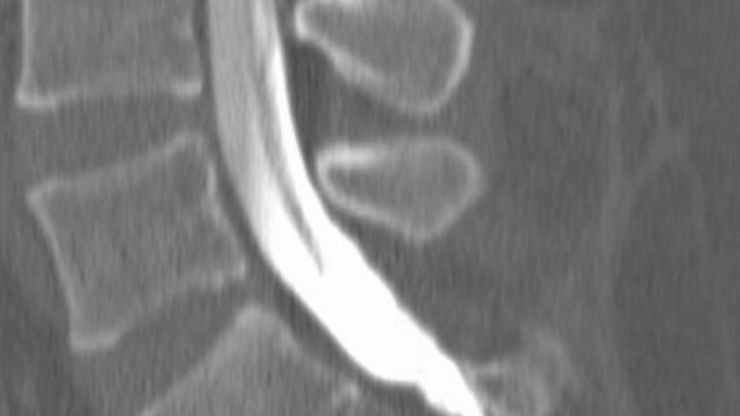Myelography - Myelograms

Myelography is an imaging test performed using an injectable contrast material to evaluate the spinal cord, its protective outer membrane (meninges) and nerve roots. Myelography produces an image called a myelogram. Myelography is helpful to detect and diagnose spinal disorders that cause myelopathy—or, spinal cord compression, such as spinal infections, tumors, or traumatic injuries. Myelopathy symptoms are neurologic and may include neck pain, back pain, numbness, tingling sensations, and/or difficulty buttoning a shirt or walking.
About Myelography
Myelography is often performed by a neuroradiologist; a radiologist who specializes in imaging the nervous system and spine. The test is usually performed on an outpatient basis at a hospital or a radiology clinic. After the images are processed, the neuroradiologist interprets the results and sends a report to your physician.
The test involves injecting a contrast medium into the dural sac; a protective membrane covering the spinal cord and nerve roots. The contrast improves the detail of the imaging studies, such as x-ray, CT scans or MRIs.
What to Tell Your Physician
It is important that the physician who orders the myelogram knows ahead of time if you have any of the conditions listed below. Depending on your personal medical history, your physician may need to provide you with special pre-test instructions and/or relay particular information to the neuroradiologist.
- Allergy to contrast media, or other allergies (eg, latex)
- Angina
- Breastfeeding
- Diabetes
- Difficulty urinating
- Epilepsy
- Kidney disease
- Pregnancy
- Take a blood thinning medication
- Unable to lie on your stomach or lie still
Myelography involves two essential steps:
- Injection of a contrast medium into the space surrounding the spinal cord and nerve roots.
- Utilization of x-ray (fluoroscopy), CT scan or MRI to obtain still images of the spine.
Step 1: The injection is performed using sterile procedures. After changing into a gown, you are positioned either on your stomach or side for the injection.
- The injection area of the skin is cleansed.
- A numbing medication is injected to help make the procedure more comfortable.
- After the numbing medication is given time to work, the contrast medium is injected.
- During the injection you may feel a sting or gentle pressure on your back as the needle is inserted. Some patients have reported sharp but momentary pain.
Step 2: The neuroradiologist uses fluoroscopy—real time video x-ray—to make sure the contrast flows into the targeted area of the spine. Then the required x-rays, CT scans or MRIs are obtained.
Preparing for Myelography
Always follow the instructions your ordering physician and/or neuroradiologist provides. In general, most instructions may include the following:
- Make arrangements for someone to drive you to the hospital/radiology facility and home after the test.
- You may be asked to bring copies (eg, CD) of previous and relevant x-rays, CT scans, or MRIs for the neuroradiologist's review. Previous radiological studies may be compared to the myelography images.
- Do not eat anything after midnight the night before your myelography appointment. Clear liquids are usually acceptable.
- If you need to take any medications the day of your appointment, take them with clear liquid (eg, water), unless your physician has given you other instructions.
- It may be suggested that you leave jewelry and valuables at home.
Myelography Procedure Aftercare
After myelography, you are taken to the recovery area. There you rest lying down for a period of time up to 4 hours. Some patients are positioned to lay with their head elevated. Radiology staff monitors you during this time.
When you are discharged home, your instructions will include:
- No strenuous activities for 24 hours, and avoid bending movements for 48 hours.
- Drink plenty of fluids such as water or juice to clear the contrast from your body.
- If you are breastfeeding, you may be told to feed your baby formula for a day or so after the test.
Potential Myelography Side Effects
Common side effects include headache, aches or discomfort in the arms or legs, nausea, vomiting, and dizziness. Most patients do not experience any side effects, and when side effects do occur, they usually disappear within 24 hours.
If side effects persist longer than 24 hours, or you develop a fever over 100.4F degrees, contact your physician, the hospital or radiology clinic where the test was performed.
